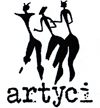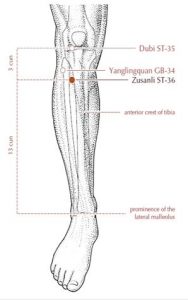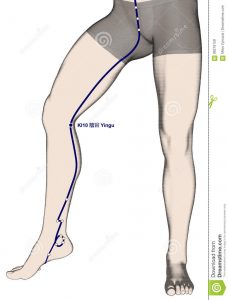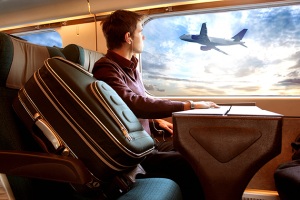 Written by Zuna Vesan_2016
Written by Zuna Vesan_2016
Translated by Žubra Žubretovská_2021
Editing consultant Julianna Bloodgood-Habel
The life of a dancer, especially a freelance dancer, is accompanied with a suitcase being constantly on the alert. The dancer doesn´t even take some of the things out of the suitcase, it´s not worth it. Traveling holds the same part of our life, as does a warm up before training. Many of us cannot imagine our profession without traveling. However, this chapter is for everybody, because every one of us travels from time to time, and so we all fall out of our common rhythm. It hits some more and some less. What does it depend on?
When we are young, we don´t feel some special intervention to our organism during and after traveling. Usually, a young body adapts to changes very fast, it doesn´t feel any notable tiredness or health issues. We mostly feel pleasant excitement from discovering the new. But this latency of consequences is tricky. Based on my communication with many dancers and actors of movement theatre from all around the world, I point out, that with rising age every one of us starts to look at traveling differently. While we are young, we are craving possibilities to travel, when we are older, we feel that traveling is draining us more and more. We start to calculate the time we spend traveling, and begin to think more about the relaxing or recovery days and how to organise them. The journey for us is not only some common relocation, for us, traveling starts to be work itself.
What is happening during traveling?
Firstly, let´s look at it with the eye of Western scientific perspective. When we go very fast in a car, bus, or train, not even speaking of airplane, our nervous system knows that it is being exposed to danger. Thanks to its ability to supress feelings, the brain overcomes it of course – it is a way of adaptation of the organism to new conditions and it was given to us so we could survive. We are trained for it from childhood, we teach it to small babies, when we are buckling them into their car seat. But the body knows by itself, because it has the vestibular system which tells the body what speed it is moving. So, the body is naturally afraid, afraid in the deep subtle structures, and so obviously a reaction of our system must happen. The majority of the time we are tired because our body needs to compensate the stress with a total shutdown. So that is why resting after travel is reasonable.
During flights through time zones, something even more serious happens to our system. What is known as “jet lag” is a state of total scatter of our body´s daily rhythm. During it, our circadian rhythm is disrupted, which is one of the biorhythms. It takes approximately twenty to twenty-four hours, depending on the individual and the conditions. This rhythm is responsible for managing physical functions, for example, alternating between sleep and vigilance, regular changes of body temperature, secretion of hormones, or blood pressure level. This rhythm is directly dependent on the amount of daily light. If we stint ourselves from the amount of this light with a “jump” through a time zone, or on the contrary, we prolong it, it will influence the secretion of the sleep hormone -melatonin, which is responsible for the feeling of sleepiness and it allows us to fall asleep. If it is disturbed, we have problems. Our natural circadian rhythm, which we were functioning with the past few months, or years, suddenly breaks. And with this, all the physical processes, that are dependent on it, get confused and damaged. The more time zones we cross, the worse the manifestation of jet lag are. We can experience buzzing in the head, muscle or joint pain, we can be grumpy, hypersensitive to light and sounds, lose our appetite, or generally not feel like ourselves. Problems with sleep are a guarantee – during the day we feel strong tiredness and fatigue, and on the contrary, in the middle of the night we wake up. We cannot fall asleep again, and yet, we are so tired that we are not able to stay awake either. Women can experience disruption of the menstrual cycle, which can be prolonged by a week or two. The manifestations of jet lag are generally less with flights to the west, because we actually prolong the day. The adaptation happens faster, but it is also strong. The symptoms are worse and longer with the flights to the east. Depending on the individual, the state of the organism and the number of time zones crossed, jet lag can last one to three days, but in some cases even a week. If I point out that some dancers are flying through four time zones, five times a year, we can all agree that it is really a big challenge for the organism.
How do Taoists look at it through the Chinese medicine?
The ideas expressed in this book are thousands of years old. Airplanes did not exist, let alone the possibility to relocate to another hemisphere of our planet at such a high speed. But traveling always existed, even in ancient China, people were traveling for business long distances also outside of China.
Chinese Medicine cannot measure hormone levels, it did not discover the vestibular system, or circadian rhythms, but it looks at this topic with its own perspective and its own terminology. If we understand it, we discover that it is not far from the Western point of view. Firstly, by traveling we disrupt the phase SOIL in a human. As we know, the phase SOIL is dependent on regularity, on rhythm, and with traveling this rhythmic chain will be broken. The intensity of the break is proportionally dependent on the length of traveling and conditions which we are traveling in, and where we are traveling to. The organs of the phase SOIL, spleen and stomach, must function excessively, so that regularity is reestablished. The second circuit which is influenced by traveling, is the phase WATER – our prenatal source – kidneys. Kidneys, as our deepest source of Qi, are responsible for our deepest and most subtle processes, so for our biorhythms. If it is interrupted, the kidneys must function markedly more, to take us back to our normal biological function. On the topic of fear from speed, we also arrive to the kidneys. Fear from the perspective of Chinese medicine is related to kidneys, it weakens them. Kidneys themselves are the basis of our vitality and our health, and if we over drain their Qi, we are using our reserves. Speed itself is yang. During harmonisation of this state, the kidneys are sending yin to the system. It is yin that in other cases would be used differently, for example for the regeneration of the organism, or blood nourishment. It winds down to over consumption. So, it is logical that after traveling we feel tired. Even though we are sitting on our butts, the system of our body is functioning on full tilt. That is why I am repeating – it is necessary to give yourself deep relaxation after traveling!
Finally, the heart is involved in this process too. As we know, the heart is the residency of our spirit “Shen”, our soul. Even though during traveling our body relocates very fast somewhere else, the soul needs a little bit more time to “catch up” to the body. Maybe it sounds too esoteric, but the well-known feeling of “not being in our own skin”, is exactly what I am talking about. It can be accompanied with different strange dreams. After traveling to the destination, it is necessary to give yourself relaxation, it means not to bother yourself straight away and too much. Then we give the soul time to catch up to the body and unite with it.
The result of all of this is that a person with a strong middle, with good Qi of stomach and spleen, but also a person with good Qi of kidneys, handles traveling better. So, it is logical that an older person who is generally loosing energy, will feel discomfort from traveling.
Another factor connected to traveling.
Home.
The feeling of home is incredibly important for a person, it is also important for the phase SOIL in the person. Home is our external centre which we can lean on. There can be times, when dancers don´t have a home, they have it temporarily in the suitcase. It requires from them a big dose of adaptability. Or they are changing several homes in short period. Or some of them have many homes at the same time, which also requires the ability to adapt because during this time the earthly organs are on the alert.
The older the dancers are, the less they experiment with the absence of home and the deeper and stronger they feel their roots. Rising age is creating for them the need to spend more time at home and if they are supposed to travel somewhere, they make sure it will be as short as possible.
Nutrition.
The Second factor which is strongly influenced by traveling is the change of cuisine and so the influence on eating habits and eating needs. In a new place we don´t have our own kitchen, many times we don´t have any kitchen at all and so we cannot eat and refill our Qi according to our needs. It can be “part of the game” of how to manage to adapt in those conditions, but it is undeniable that it excessively influences our state and Qi. So, we solve our nutrition with restaurants. Sometimes it can be freeing, but not always suitable. Since it is not always possible to buy what we need in the shops, we often cover hunger with buying junk food. It is a load for the organism.
Journey is not the right time for work.
Many of us perceive traveling as time for work, time which should be used productively. Because of great busyness, it is often the only time to reply to emails, or to plan our work or private life. Many of us, as soon as we get into the means of transport, open our laptop, look at the screen and work. I note that also surfing or scrolling of Facebook statuses is mental work which is tiring to the organism. We can suppress the symptoms of fatigue very quickly when we are young, however with rising age we start to perceive the journey itself as work and that is why we don´t add any other work to it. Fortunately, the body is sometimes stronger than the mind. Even if we plan work in trains or busses, after few kilometres we fall asleep. In some cases, we are not capable of focussing on work, and so we only listen to music or observe the scenery. The fact that the body is forcing us to sleep during travel, indicates that traveling actually isn´t the right time for work for our organism. That with this relaxed state, our body needs to balance that it has more than enough work with this situation.
Coffee.
Covering tiredness with coffee, or possibly with other stimulating substances, is very dangerous. What does our body tell us when we are tired? It gives us a message that our system is overworked and that if we don´t want it to wear out very quickly, or denounce service, we should respect the voice and relax. During tiredness the kidneys are “screaming” the most, which are the source of our prenatal Qi and they don´t want to use it all. They want to save it for next the years of our life. The body wants to protect us from other exhaustion with this feeling of tiredness. After coffee we feel excitement, however, only with a short effect. In the end we reach our own reserves and therefore we exploit our kidneys. If we do this regularly, we are tiling a way to many illnesses which otherwise wouldn’t have to manifest.
The result of all of this is:
- Let´s travel in a way to have time for rest and relaxation. No work during traveling. After reaching our destination where we are supposed to teach, or perform, ask the organizers for free days, do not perceive them as a luxury. To reach a destination in the evening and start working in the morning is a killer.
- Never fly in a plane the day of the performance.
- Let´s try to think about the possibilities of nutrition before, ask the organizers before and ask them to secure basic conditions for us.
- Keep the hydration mode during traveling.
Some advice to better handle jetlag:
- A few days before the flight, start gradually changing for the time zone where you are preparing to travel.
- If it is possible, fly with a night flight with the arrival to the destination in the early morning.
- Avoid drinking alcohol during the flight.
- Drink enough water.
- Try to sleep during the flight.
- Do not work during the flight.
- As soon as possible after the arrival, move in the fresh air and daily light.
- Do not go to sleep after arrival but try to stay up until the evening of the place of arrival.
- After flying over time zones, secure for yourself a minimum of two days of rest before you start working.
After arriving home from the business trip permit yourself:
- A lot of sleep.
- Passive relaxation, walks in fresh air.
- At least two days of relaxation before you start working again. Even longer according to the length of the journey.
- Eat quality and regular food.
From the perspective of Chinese medicine, we can also help ourselves these ways:
With any traveling, but especially with longer and harder traveling, it is important to dedicate to your centre -the organs of spleen and stomach. One of suitable ways is moxibustion of the point Zusanli – ST 36, so 36th point on the stomach meridian (see picture). You can read about moxibustion in the chapter/blog “Moxa in the dancer´s first aid kit”. It is suitable to start with moxibustion a week or two before a flight, and then continue with it after arrival, too. The choice of nutrition, supporting these organs, is also a good solution of filling Qi. Chinese medicine also offers several herbal mixtures supporting these organs. Strengthening the centre is essential. If the centre is strong, we don´t dig into our reserves from the kidneys. However, supplementing treatment can also help the kidneys through point Yingu KI 10, 10th point on the kidneys meridian (see picture). It is in the furrow under the knee, between two ligaments on the internal sides of the knees. You can push the points or use moxibustion on them shortly. These are the points of our biorhythm. We teach moxibustion at our workshops.
From Zuna´s book “TAO of movement”.
Written by_Zuna Vesan_2016_editing consultant Julianna Bloodgood-Habel
Translated by Žubra Žubretovská_2020
Spine is the basic structural pillar of our body. Dancers should be aware of their spine from the constructional, but also from the energy point of view. It will help them make full use of its plasticity, get aware of its movement possibilities and structural connections with other parts of the body. However, they will also recognize its limitations and, when respecting them, the can avoid its destruction and pain.
From a purely practical anatomical point of view, the spine is a collection of vertebrae verticaly arranged in a column, where this column is more a kind of an alive snake, twice curved in a S-shape. This curvature ensures spine mobility, flexibility, functionality and a lively support ability. The construction of the spine allows a person to walk vertically and protects the spinal cord that “flows” through it. It is actually a kind of bone coat of the spinal cord and also it functions as a distribution system, because nerves emerge from the spinal cord through the openings between the vertebrae to connect via their sensitive paths with the whole body.
At the first glance it does not look like it, but the spine actually “flows”. The spaces between the vertebrae are filled with cartilaginous intervertebral discs. These are water-bearing, they allow spine mobility and flexibility. They are able to soften shocks and shakes with their liquid structure, protecting them. They also protect the flow of Qi that streams through the spine. We can also imagine the spinal cord as an extremely dense fluid in which Qi ‘flows’. All the information, all the data of our nervous system “flow” through the spinal cord and nerves. Movement of the spine can therefore have a very fluid, smooth and soft character.
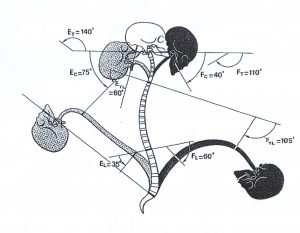 Many of us limit our perception of the spine to feelings of pain in some parts of it which we tend to stress more and incorrectly. The tiny ligaments holding the vertebrae together often hurt; the muscles that have to hold this structure and balance the incorect posture of the body also ache. The culmination of our misunderstood opportunity to work with our own backbone are the disc problems – displacement, ejection and their degeneration. Unfortunately, these are often the only perceptions in which people realize that they have a spine. But the spine means much more for us. In addition to the construction pillar, it is also a pillar of our overall personality, it is a “skeleton” of our identity. It’s what we can rely on, it’s a solid back, a support, a reinforcement, a refuge. The term “skeleton of our identity” means what we identify with in this life. The spine is a protective structure for our mission to be fulfilled here. No wonder that the delicate part of our body, such as the nervous system, is connected to the spine. No wonder, that the fibers of our nervous system “flow” in the thick bundle of the spinal cord from the brain directly through our backbone, because they have there the necessary support and protection. And, they use the spine as their distribution center. Taoists have discovered that there are energy channels in the spine area through which a very strong Qi stream flows. The spine thus creates a kind of Qi flow path that can flow through it and then spread throughout our organism, thus nourishing it. The life-giving Qi flows through these channels, from them to the organs of the body, into each cell. This way it provides them with the nutrition they need for their growth, function and healing.
Many of us limit our perception of the spine to feelings of pain in some parts of it which we tend to stress more and incorrectly. The tiny ligaments holding the vertebrae together often hurt; the muscles that have to hold this structure and balance the incorect posture of the body also ache. The culmination of our misunderstood opportunity to work with our own backbone are the disc problems – displacement, ejection and their degeneration. Unfortunately, these are often the only perceptions in which people realize that they have a spine. But the spine means much more for us. In addition to the construction pillar, it is also a pillar of our overall personality, it is a “skeleton” of our identity. It’s what we can rely on, it’s a solid back, a support, a reinforcement, a refuge. The term “skeleton of our identity” means what we identify with in this life. The spine is a protective structure for our mission to be fulfilled here. No wonder that the delicate part of our body, such as the nervous system, is connected to the spine. No wonder, that the fibers of our nervous system “flow” in the thick bundle of the spinal cord from the brain directly through our backbone, because they have there the necessary support and protection. And, they use the spine as their distribution center. Taoists have discovered that there are energy channels in the spine area through which a very strong Qi stream flows. The spine thus creates a kind of Qi flow path that can flow through it and then spread throughout our organism, thus nourishing it. The life-giving Qi flows through these channels, from them to the organs of the body, into each cell. This way it provides them with the nutrition they need for their growth, function and healing.
These channels are so-called Governing vessel through which runs Qi on the back of the spine and Conception vessel through which Qi flows on the front side of the spine. Both of these channels start to activate in the human kind shortly after the conception and develop completely in the embryonic stage. Governing vessel affects many health but also psycho-spiritual areas. Its activity is closely linked to our innate original Qi and its source in the kidneys. If Qi is lacking in this channel, one has a problem with his identity, he has no “back to lean on”, he suffers from a lack of courage in his life. In the belt area, opposite the navel, there is a place through which we “inhale” rules and principles which we work with in our life. This place is called Mingmen, The Gate of Destiny. Children without parents often have weakness in this channel, they have difficulty finding certain frames and principles in their lives. Governing vessel springs in the depths of the pelvis, passes through the sexual organs, enters the spine and through it enters into the brain, to the cranium, then it continues through the third eye, nose and ends in the mouth. Here it connects with the Concention vessel. It also rises in the perineum, passes along the front side of the spine upwards, ascends into the navel, leads through the solar plexus, the sternum through the neck to the throat and the oral cavity. This channel has a strong influence on the ability to conceive a child, but in a psycho-spiritual context, on the ability to conceive anything, that is, to be a creative person. These two channels are deliberately interconnected in the meditation techniques in the mouth by placing the tongue to the palate. The tounge is like a switch that connects these two Qi channels and activates their common flow. This Qi circulation is the basis of Qigong or Tai-Chi-Quan exercises, and Taoists say they link „microcosmic orbit“.
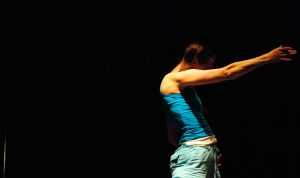 Another channel related to the spine is the Bladder meridian. It is the longest energy channel of the body, connecting our body from top to bottom, from the head through the torso to the feet. There are acupuncture points on this channel in the spots where nerves are separated from the spinal cord along the entire spine to continue and nourish the body. They are so-called transport points which, when stimulated, are able to nourish all the organs of the body through their connection to the nervous system. This is an evidence that our nervous system is highly interconnected with the energy system. Bladder meridian is the only channel in the body that has such an impact on all organs.
Another channel related to the spine is the Bladder meridian. It is the longest energy channel of the body, connecting our body from top to bottom, from the head through the torso to the feet. There are acupuncture points on this channel in the spots where nerves are separated from the spinal cord along the entire spine to continue and nourish the body. They are so-called transport points which, when stimulated, are able to nourish all the organs of the body through their connection to the nervous system. This is an evidence that our nervous system is highly interconnected with the energy system. Bladder meridian is the only channel in the body that has such an impact on all organs.
Working with the spine consciously in dance will help us to connect with those psycho-spiritual contexts and, by the movement cultivate Qi in our spine and thus vitalize and heal it.
Knees are the most commonly injured joints of dancers and other movers. But our dancing really depends on them – on their health, strength and well-being. Indeed when dancing, we place significant stresses upon them. In addition to supporting almost our entire bodyweight. Movement invention requires great adaptability, fast responses, stability, and complete flexibility. With contemporary “floor work” techniques, in which the movements are performed on the floor and on the knees, meaning we demand an almost iron like strength from our knees.
A complex mechanism
Despite its seemingly innocuous appearance, the knee belongs among the most complex of joints. The correct function of the knee joint is reliant upon the co-operation of several parts of a chain (the pelvis, hip, upper leg, lower leg, ankle and foot) that must all work together and depend on each other for function and movement.
The knee bones are the deepest structure; they provide strength, flexibility and stability by utilising the entire skeletal system. It is the connection of the femur with the bones of the lower leg (tibia) and a part of the Patellofemoral groove and the kneecap (patella). The surfaces of the bones that are part of the hinge joint are covered with articular cartilage. Together with synovial fluid, cartilage allows the bones to move freely while reducing friction and protecting the bones from wear as the joint moves.
The function of the knee ligaments is to attach bones to bones and give strength and stability to the knee in the individual positions that movement requires; the menisci help the ligaments with that. The muscles provide the source of movement. Thanks to their ability to shrink and release, the knee is able to bend, thus offering the body numerous possibilities for movement. The knees are at the same time interconnected by these connective tissues with the other parts of the body – primarily the hip and ankle joints. The condition of the knees thus affects them, and vice versa; the correct use of these joints, as well as the quality of the tendons connecting the muscles to the knees, affects the condition of the knees themselves.
Of course, blood vessels and nerves also pass through the knees.
The knees are nourished by blood transported through blood vessels; nerves transfer brain impulses to trigger movement, and in return deliver information about the condition and movement of the knees to the brain. Such information includes pain, one of the warning signals that all is not well with the knee. The energy pathways – the Meridians – also pass through the knees. They link the knees to important organs and their systems – the spleen and stomach, liver and gallbladder, kidneys and urinary bladder. The spleen provides the muscles with nutrition, while the liver is responsible for feeding the tendons and ligaments, their strength, elasticity, endurance and the ability to give muscles “drive”. The kidneys are responsible for the health of bones, cartilage and menisci. In the dance profession, we often encounter knee strains, stretching or tearing of the ligaments, meniscus damage or water on the knee. Each of these problems can restrict our plans and activities. And it’s then up to us to ensure we start listening to our knees to avoid more significant problems.
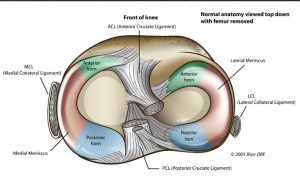 Meniscus – a unique tissue
Meniscus – a unique tissue
Menisci are special crescent shaped cartilage. There are two menisci in each knee joint – medial and lateral, located one on each side of the knee. The meniscus provides a cushion between the femur (thighbone) and tibia (shinbone). The natural weight and movement of a body would cause the bones to become very close to each other, reducing the area between the bones to such an extent that their surfaces would become damaged by friction. The main task of these is to reduce friction while moving and to absorb shocks from jumping and landing. Because the menisci help spread out the weight bearing across the joint, they keep the bones from wearing away at friction points and keep the joint in it’s natural position.
Menisci are “intended” by nature to work in coordination with our body and not cause problems. It’s not a fixed, rigid structure, but elastic and flexible, being adaptable to individual conditions. The menisci can be likened to some kind of rubbery mouldable substance that constantly adapts to various conditions. While always retaining its crescent shape, it adjusts the thickness of its individual surfaces depending on the position of the bones within the knee during any given movement. It does this because of it is constant “desire” to fulfil its most important function – the protection of the knee joint. And as the movement of dance is often unexpected and quick, the menisci are able to respond unexpected and quickly. But there must be certain limits. This incredibly collaborative joint also needs our care. It needs anatomically healthy knee use, proper knee utilisation, knee protection from “dance knee pads”, to be warmed up and prepared sufficiently before performing or training, regeneration time and quality nutrition. If it receives these elements, it does not scream for help. If not, then the pain from the knee will be heard. If this cry for help is ignored, the condition develops into gradual meniscus deterioration, followed by the deterioration of the bone cartilage and eventually the entire knee joint. Once in this state, the knee is like a car without wheels. Even though it still looks like a car, it will not carry us very far due to the friction of the road and the unpleasant screech.
With the above in mind it is clear that meniscus damage indicates we have gone too far. We also process the theme of humble acceptance psychosomatically and symbolically through our knee joints. Nowadays, we don’t have the need to bow down, be grateful, bend and humble ourselves. The ideal of today’s times is a stubborn man keeping his head raised, a person who sometimes pushes the limits right to the edge. No wonder knee problems, and particularly meniscus damage, have gained considerable scope. The basis of meniscus injury is overload, and this disability throws light on some kind of pride and blindness. One should know their limits and realise when their efforts and performance are pushing beyond their boundaries. The inability to accept the real state, by suppressing modesty, ignoring the warning signals, especially in the form of pain, leads to the inevitable fact that (people? Human beings?) man will have problems with the menisci.
Pushing our boundaries also leads to additional inconveniences – from over stretching to even snapping of the ligaments. The knees are naturally protected against dislocation. The bones are connected and the knee joint given strength and stability by ligaments. The anterior and posterior ligaments are the major joint stabilizers. The anterior ligament and the posterior ligament cross each other at the centre of the knee. The anterior ligament limits rotation and forward motion of the tibia while the posterior ligament limits the backwards motion of the knee. There are also ligaments on the sides – medial collateral and lateral collateral ligaments. These fulfil the function of limiting sideways motion of the knee. So when they become damaged, the stabilizing function can be reduced, even lost, resulting in instability of the knee.
The ligaments must be firm and flexible at the same time. They have their limits and needs. If we want to execute excellent achievements with our knees, the knees must be fully warmed up and prepared before beginning training. Another suitable option is Qigong, which brings beneficial energy (Qi) to the knees. (Read more about Qigong for movers in this blog). On the other hand, the knees are also tightened and strengthened by movement itself, respectively the movement of the knee itself supports the ligaments and tendons, their strength and flexibility. However, movement must be executed anatomically correctly. The quality of the ligaments and tendons is also enhanced by our diet, the harmonic energy of the liver, sufficient regeneration time, appropriate preparation prior to exercise and the proper anatomical movement of the knees.
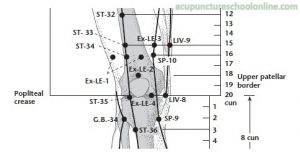 Energy Flows
Energy Flows
I have mentioned various organs of the body that to ordinary people do not seem to be related to the knees. According to Chinese medicine, however, the meridians mentioned above align these organs bringing not only the knees but also all other joints, into play. Menisci, cartilage and knee bones are, according to Chinese medicine, replenished by energy from the kidneys. If we wish to keep them healthy, it is advisable to look after the kidneys and nourish them with a good diet and energy. The tendons and ligaments, as I have already mentioned, depend on the condition of the liver.
There are very strong energy points located in the knee areas, situated on the meridians. This means that the knees are a kind of “meeting point” for the flow of energy. This is another reason why ensuring they remain in good condition is so important. So energy can flow naturally to where it’s intended to go, but only on the condition that the knees are in a state of harmony. I will mention the most important points and their most important effects. Zusanli (ST 36) is a point located just below the knee, on its lateral side, along the Stomach Meridian.
It is one of the strongest immunostimulatory points in the body, it supports the stomach and spleen in the processing of food and its transformation to energy. In close proximity is the Yanglingquan point (GB 34) located on the Gallbladder Meridian. It is, among other things, a master point for the tendons that nourishes, regenerates and cares for their continual healthy condition. On the medial side of the knee, the Yinggu point (KI 10) is located on the Kidney Meridian. It is referred to as the biorhythm point, and is responsible for acclimatising our organism to changes in living conditions. It is often used, for example, for rapid adaptation of the body across time zones, thus helping with “jet lag”. Midpoint of the transverse crease of the popliteal fossa, between the tendons of the biceps femoris and semitendinosis there is the Weizhong point (BL 40), which, among other things, is often used for its ability to release blockages in the lumbar spine and sacrum, thereby eliminating pain in that area.
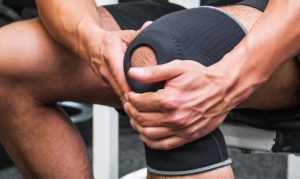 Psyche
Psyche
In addition to caring for the knees with the proper anatomical use of the body, through their protection (also by using “dance knee pads”), sufficient regeneration time and good nutrition, relaxation of the psyche and awareness of certain life linking events also helps the knees. I know from my own experience as a dancer, but also as a therapist, that with initial knee problems, sometimes all you need to do is “just“ be aware of something, which may not seem important at the time. Finally, in addition to the theme of humble acceptance that has already been mentioned, I will mention one more connection, between the knees and our psyche. Symbolically, joints are a means of connecting one thing with another. They are crossroads for the circuits of Qi energy. Problems with joints occur when there is no natural interconnectedness of things, phenomena, situations, relationships … if the body doesn’t connect with the soul, spirituality with materiality, and so on. At the same time joints are also points where the Chi energy travels from one part of the body to another, so on the psychic level this is related to the ability of a human being to form connections and be able to use them in one’s own life.
From Zuna´s book “TAO of movement”.
Translation of this text is supported by Slovak Art Concil

